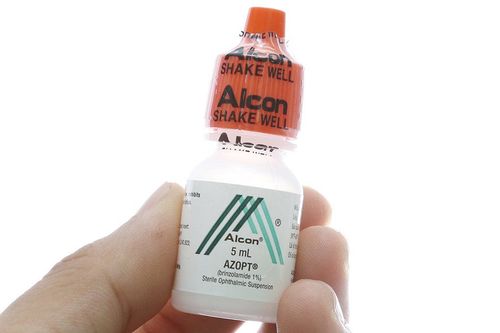This is an automatically translated article.
Bimatoprost is a medicine that treats eye diseases, specifically glaucoma. With the dosage form of eye drops or implant, Bimatoprost is used to lower intraocular pressure in patients with glaucoma and chronic open-angle glaucoma.
1. What is Bimatoprost? Uses of Bimatoprost
Bimatoprost belongs to the group of drugs that lower blood pressure, with the main ingredient being Bimatoprost. Active ingredient Bimatoprost works to lower intraocular pressure by increasing drainage of aqueous humor. Lowering intraocular pressure, or in other words, reduces the pressure in the eye to help prevent blindness caused by the disease.
Bimatoprost is prepared in many different forms and strengths such as Bimatoprost 10mcg corneal implant, Bimatoprost 0.1mg/ml, 0.3mg/ml Bimatoprost eye drops solution and Bimatoprost 0.3mg/ml combination eye drops and Timolol 5mg/ml. Bimatoprost is indicated for use alone or in combination with beta-blockers for the treatment of glaucoma in patients with glaucoma and chronic open-angle glaucoma.
2. Usage and dosage of Bimatoprost
Depending on the dosage form, method of administration and dose of Bimatoprost varies. In addition, the choice of preparations with the right amount for treatment also depends on the severity of the disease. However, it should be noted that the drug is only used in people 18 years of age and older.
Dosage of Bimatoprost for each specific dosage form is as follows:
Eye drops: Put 1 drop into the affected eye once a day in the evening. If both eyes are affected, do not use both eyes at the same time, but at least 5 minutes apart. Before instilling the medicine, wash your hands thoroughly and do not let the dropper touch your eyes or hands. Implant: Inoculate the anterior chamber 1 stick 10mcg. With this form of Bimatoprost , the dose and administration are determined by the doctor.
3. Bimatoprost . side effects
Bimatoprost can cause some unwanted side effects with the frequency of occurrence as follows:
Common: Eye irritation, eye itching, eye pain, blurred vision, corneal edema, keratitis, iritis eyes, anterior chamber inflammation, eyelash growth, erythema on eyelids, eyelid pruritus, conjunctival congestion, eye hyperpigmentation, skin hyperpigmentation. Uncommon: Bimatoprost rarely causes nausea, headache, dry skin, urticaria, eye pruritus, blurred vision, conjunctival edema, conjunctival disorder, eyelid scab, eyelid edema, iris hyperpigmentation , loss of eyebrows, eyelashes. Frequency not known: Asthma, dyspnea, asthma exacerbation and chronic obstructive pulmonary disease, hypertension, dizziness, atopic dermatitis, skin discoloration, eye allergy, dry eye, eye edema, increased Eye discharge, photophobia, macular edema, eyelid darkening, hyperpigmentation in eyelid margin, sensation of foreign body in eye. If you see any strange symptoms after taking Bimatoprost, you should immediately report it to your doctor or go to a medical facility soon for examination and treatment.
4. Some notes when using Bimatoprost
Do not use Bimatoprost drug in people with a history of severe hypersensitivity to the ingredients of the drug (including the main active ingredient Bimatoprost and the preservative benzalkonium chloride), who have an infection of the eye and periorbital area, or suspected infection. ; patients with corneal endothelial cell dystrophy who have undergone surgery involving corneal transplants. Among the possible side effects of Bimatoprost, iris hyperpigmentation is likely to be permanent, while periocular tissue hyperpigmentation is reversible. Administration of Bimatoprost as a 0.3 mg/ml solution may cause cystic macular edema in patients with vitreous-related risk factors. Therefore, the drug should be used with caution in this group of subjects. People with a history of viral infections in the eyes or with iritis, uveitis should be cautious when using Bimatoprost 0.3mg/ml because of the risk of eye infection or corneal infiltration. Avoid contact of Bimatoprost with other areas of the skin, especially the cheeks, as this may increase hair growth. Treat with caution with Bimatoprost in patients with respiratory disease such as dyspnea, chronic obstructive pulmonary disease, asthma because the drug can cause exacerbations of the disease. People with low blood pressure, bradycardia should use Bimatoprost 0.3mg/ml eye drops with caution because the drug can cause hypotension or bradycardia. Like other eye drops, Bimatoprost also contains the preservative Benzalkonium chloride, so it can discolor soft contact lenses and cause some eye damage such as eye irritation, toxic corneal ulcers. , superficial punctate keratitis. Therefore, in patients who have to take Bimatoprost regularly, it is necessary to closely monitor for signs of dry eyes or corneal damage. If using soft contact lenses, before instilling, the patient needs to remove the lenses and wait at least 15 minutes after instilling the medicine before putting the lenses back in. Women who are pregnant and breastfeeding should not take Bimatoprost because this is a risk group when using the drug. Bimatoprost may cause transient blurred vision, so patients need to wait until their vision is clear as usual before driving or operating machinery to be safe. Bimatoprost may interact with drugs containing prostaglandins and reduce the antihypertensive effect of the drug. The use of Bimatoprost is to lower intraocular pressure to prevent complications of blindness in people with glaucoma and chronic open-angle glaucoma. Patients need to follow the doctor's instructions for the drug to be effective.
Please dial HOTLINE for more information or register for an appointment HERE. Download MyVinmec app to make appointments faster and to manage your bookings easily.













